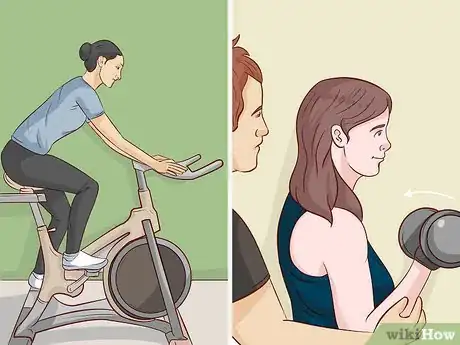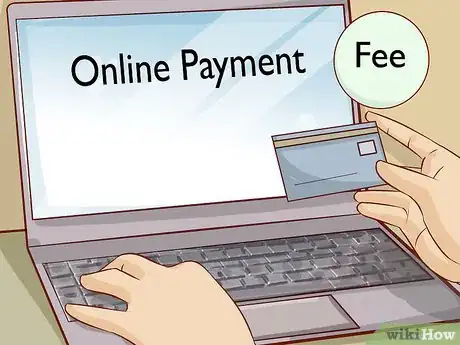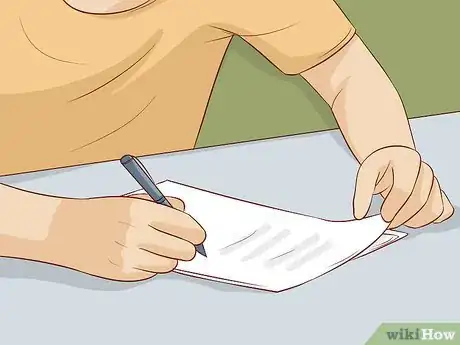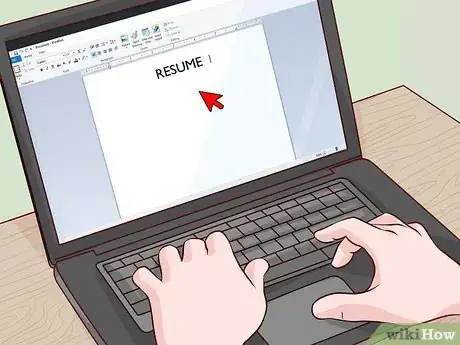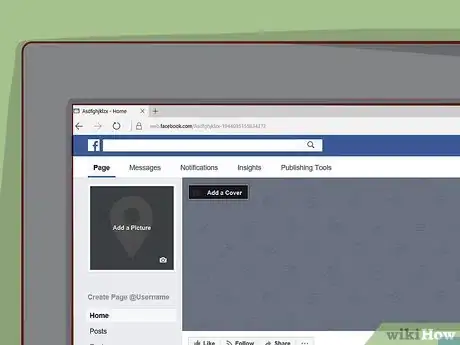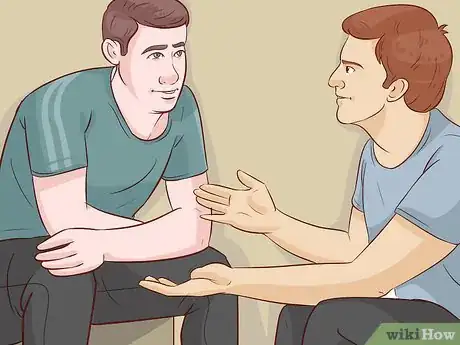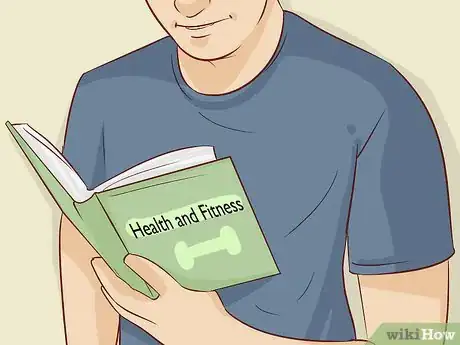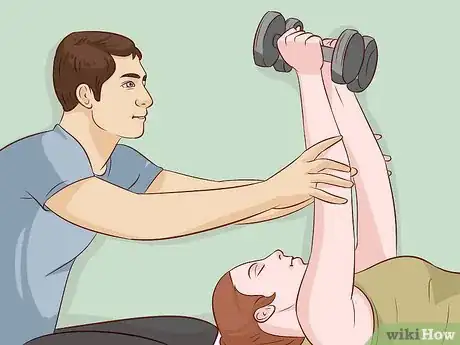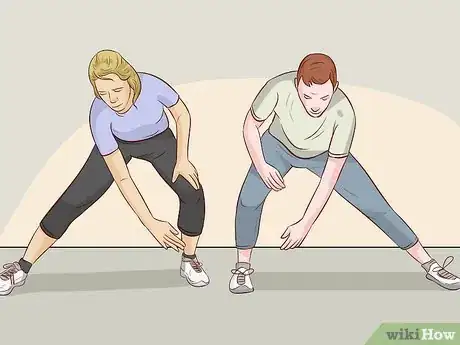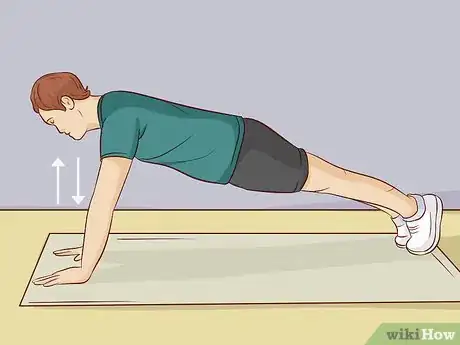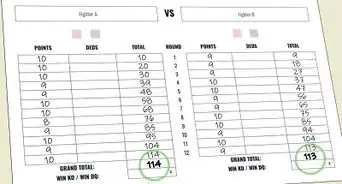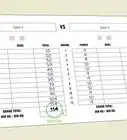This article was co-authored by Marilin Karst. Marilin Karst is a Fitness Choreographer, Health and Fitness Coach, and the Co-Owner of Fiesta Fit Sisters. With nearly 15 years of experience, she specializes in wellness coaching and fitness instruction. She studied fitness, nutrition, and leadership at the Instituto Peruano Del Deporte. Marilin is certified by the American Council on Exercise as both a Health Coach and a Personal Fitness Trainer-Health Fitness Instructor. She’s also certified to teach Zumba Basic, Zumba Toning, and Zumba Kids.
This article has been viewed 23,609 times.
A fitness coach helps someone achieve their fitness goals by teaching them exercises and wellness strategies. If you're hoping to become a personal trainer, the first step is narrowing down your focus to one type of fitness. Look for a certification program that you can take to prepare you for the certification exam. Once you've finished the program, take the exam to obtain your certification, letting you start training clients. Either start applying to fitness jobs you're interested in, or market yourself as a personal personal trainer to gain clients and start your fitness coaching career.
Steps
Becoming a Certified Coach
-
1Decide what your fitness focus will be. Choose whether you’ll be a group fitness instructor, teaching things like cycling, step aerobics, or boxing, or if you’ll be a personal trainer who only works with individual clients. Decide if you want to work in a class setting, work one-on-one, or even do both, as well as picking a specific type of fitness.[1]
- Most professional fitness certifications, like ACE or NASM, offer certifications for many different specific types of fitness.
- For example, a group fitness instructor might take the ACE Group Fitness Instructor Exam, while a personal trainer could get their certification through the National Academy of Sports Medicine (NASM) with a weight loss specialization.
- If you’re a group fitness teacher, you’ll choreograph movements for your own classes.
- A fitness coach who only works with individual people at once will need knowledge about how to create a fitness plan based on one person’s fitness goals, meaning knowledge about various types of fitness goals is desired.
-
2Research online programs that offer the training you need. Certification programs are online courses that offer the content you'll need. Once you’ve chosen your desired fitness type, search for certification programs online that will teach you everything you need to know to pass your specific certification. Popular options include the American Council on Exercise (ACE), International Sports Sciences Association (ISSA), or the National Strength and Conditioning Association (NSCA). Each of these will let you choose the specific type of specialization you'd like.[2]
- Explore what different certification courses offer online so that you can choose the best one for your needs.
- Programs are also offered by the National Academy of Sports Medicine (NASM) and the American College of Sports Medicine (ACSM).
Advertisement -
3Enroll in your chosen program and pay all the required fees. Many personal training/fitness coaching programs have options for how much or how little you'd like to purchase. For example, you might have access to live workshops, coaches and mentors, or an accelerated program if you pay a higher price. Besides paying for the actual program, you'll likely need to pay for the exam and learning materials (such as textbooks) as well.[3]
- The prices for each organization range widely, with programs costing anywhere from $450-$1,200 or more. Some programs include the cost of the exam in their program total, so check before submitting your payment to see if it's included.
- Many programs offer deals giving you a certain percentage off if you sign up quickly.
-
4Complete the coursework to learn the certification requirements. Most fitness coaching programs are online and will offer a digital or physical textbook, video lectures, and practice exams. Take your time as you're going through the coursework, studying the information thoroughly to be sure you remember it all. Check out what kind of extra study guides or learning activities your program offers.[4]
- While participating in the program, you’ll learn about nutrition, exercise techniques, anatomy, and other topics related to your specific certification.
- These programs are usually self-paced, meaning you can take as long or as a short of a time studying the coursework as needed.
- A few programs may require that you finish the coursework in a certain amount of time, such as three months.
-
5Take the certification exam after studying all of the important elements. The exam will contain a written test, and many exams also contain a practical section that tests your understanding of proper exercise techniques. Study the program material thoroughly before taking the test so you’re sure to pass it.[5]
- Many certification programs offer study materials such as practice tests and workshops to help you get ready.
- Personal training exams will also test your ability to create exercise programs for different clients’ needs, as well as how to assess someone’s fitness level.
-
6Get CPR training, as many jobs or certification agencies require it. Whether your certification requires it or not, CPR is a very useful skill to have as a fitness coach because it ensures you can help a client out if they ever need medical assistance. Find a local CPR class near you and sign up to learn the proper training.[6]
- Find a class by typing "CPR classes near me" into an online search engine.
-
7Earn a degree in a health- or fitness-related field, if applicable. Some employers may require you to have a bachelor’s degree, or even a master’s degree, in a subject such as kinesiology, physical education, or exercise science. If you have the resources and desire to further your education, consider enrolling in a college that offers a fitness-related subject you’d like to study, taking classes in person or online.[7]
- Do an online search to find colleges and universities that offer degrees related to fitness and wellness.
Finding Clients or a Job
-
1Apply to jobs at places like boutique fitness companies and gyms. These sorts of places are almost always looking for new people to teach clients. Send in your resume or apply to open jobs at recreation centers, health clubs, dance studios, or other fitness associations.[8]
- Have a resume that reflects your skills, education, and certification related to the job you’re applying for.
-
2Build your own client base if you want to be self-employed. If you’d rather be in charge of your own schedule and work with clients one-on-one, create a brand for yourself. Decide what you’ll offer clients in the way of exercise and health coaching, gather any equipment you'll need for the training, and put your information on social media and online for people to find.[9]
- Consider creating your own website or social media page to promote your business. Advertising is extremely important so you can show your value.
- Offer to meet clients at a gym that you're a member of, or outdoors if the weather is nice. You can also try working online through a web platform. There are lots of people who don't have the time to go to a gym, but are willing to work with an online fitness coach.
- The gear you'll need to work with clients will depend on your specialized fitness instruction. For example, a personal fitness trainer might need access to things like weights and resistance bands while a yoga instructor needs yoga mats or yoga blocks.
- Bring one set of equipment to share with your client, or suggest that your client purchase their own equipment to keep with them.
-
3Spread the word that you’re a certified fitness coach using social media and videos. Make videos of clips of your workout routines so people get an idea of what it’s like to train with you. Create Facebook, Instagram, Twitter, and LinkedIn pages so that more and more people will be able to find your services.[10]
- Reach out to people locally by attending fitness meetups or workout events.
- Consider being an online-only fitness coach who creates videos for a wide audience to reference.
-
4Team up with another certified personal trainer to help you gain experience. This is a great way to learn the ins and outs of being a fitness coach in a more hands-on way. Ask a fitness coach that you know if you could teach a client or class alongside them. Pay attention to how they interact and instruct their clients to learn from their methods.[11]
- This is especially helpful if you’re nervous about coaching clients by yourself for the first time.
Honing Necessary Skills
-
1Continue learning about staying healthy, both through food and exercise. To be a successful fitness coach, learn as much about health and wellness as possible, including nutrition, how to control your weight, and healthy lifestyle practices. Use this knowledge to help your clients reach their fitness and health goals.[12]
- Knowing as much as possible about health and fitness will show that you’re passionate about the subject.
- Read health and fitness books, attend conferences and classes, watch videos, and participate in other fitness classes to help you learn new things.
-
2Stay energetic and encouraging to practice your motivational skills. A great fitness coach can motivate people to keep going even when they don’t want to. Practice this skill by doing things like staying positive when you’re teaching, using an encouraging voice, and exuding energy that’s contagious.[13]
- Watch other fitness trainers in action to see how they give off energy while motivating others.
- You might say things like, “You’re doing great! See if you can push yourself a little bit further!”
-
3Practice demonstrating and explaining different exercise techniques. This is the best way your clients will learn from you. Spend time pretending that you’re teaching someone different exercises, going slowly and making sure to explain the proper form with your words as well as with your body.[14]
- Practice explaining any safety rules that go along with an exercise, or how to tell when you’re doing an exercise right.
-
4Learn how to make modifications to your exercise routine or class. Sometimes a client or class participant won’t be able to do exactly what you’ve planned for the routine due to a physical limitation or other factor. Always have modifications planned for each exercise so that everyone is able to participate in some kind of way.[15]
- You might have different variations of an exercise depending on the person’s skill level.
- For example, you might show them how to do a regular pushup with both legs extended, with the modified version being a pushup on their knees.
Expert Interview
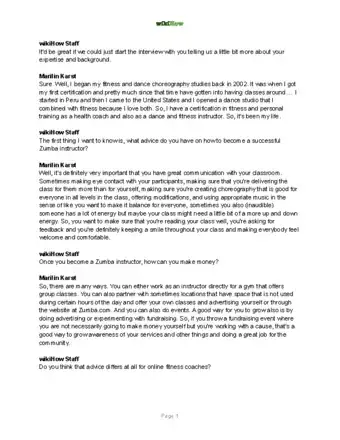
Thanks for reading our article! If you'd like to learn more about becoming a fitness coach, check out our in-depth interview with Marilin Karst.
References
- ↑ https://medium.com/@kylehuntfitness/7-ways-to-stand-out-as-an-online-fitness-coach-in-a-crowded-market-d636ccc3ed26
- ↑ https://www.exercise-science-guide.com/certifications/personal-training/
- ↑ https://www.exercise-science-guide.com/certifications/personal-training/
- ↑ https://www.exercise-science-guide.com/certifications/personal-training/
- ↑ https://www.academicinvest.com/science-careers/exercise-science-careers/how-to-become-a-fitness-coach
- ↑ https://www.zippia.com/fitness-coach-jobs/
- ↑ https://www.academicinvest.com/science-careers/exercise-science-careers/how-to-become-a-fitness-coach
- ↑ https://www.academicinvest.com/science-careers/exercise-science-careers/how-to-become-a-fitness-coach
- ↑ https://www.academicinvest.com/science-careers/exercise-science-careers/how-to-become-a-fitness-coach
- ↑ https://www.forbes.com/sites/forbescoachescouncil/2017/06/23/eight-proven-fitness-marketing-strategies-that-get-trainers-more-clients/#2a9917c139e0
- ↑ https://www.zippia.com/fitness-coach-jobs/
- ↑ https://www.academicinvest.com/science-careers/exercise-science-careers/how-to-become-a-fitness-coach
- ↑ https://www.shape.com/fitness/workouts/6-things-consider-becoming-fitness-pro
- ↑ https://www.zippia.com/fitness-coach-jobs/
- ↑ https://www.zippia.com/fitness-coach-jobs/
